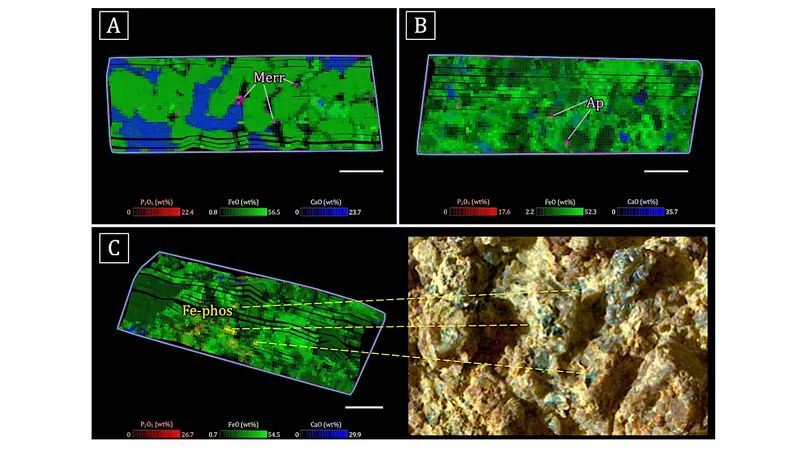
Unveiling the Secrets of Martian Phosphates: Key Indicators of Life and Planetary History!
2025-01-12
Author: Amelia
Introduction
A groundbreaking study has illuminated the significance of phosphate minerals on Mars, shedding light on the planet's past igneous and aqueous conditions. This research provides vital insights into prebiotic chemistry, historical habitability, and the potential biosignatures that could emerge from future Martian sample returns.
Research Findings
As of 2023, researchers have analyzed 378 meteorites from Mars, revealing that the two principal phosphate minerals identified are merrillite and apatites. Notably, the composition of apatite is predominantly rich in fluorine (F) and chlorine (Cl), while shergottites—one of the most studied types of Mars meteorites—show a higher presence of hydroxyl (OH) groups.
Geological Significance
The analysis of phosphate concentrations from various Mars missions paints an intriguing picture: elevated levels of phosphates have been detected in the Mount Sharp Group located within Gale Crater, as well as in the Wishstone area at Gusev Crater. In contrast, lower phosphate concentrations were recorded on the floor and fan of Jezero Crater, hinting at diverse geological processes across the Martian landscape.
Secondary Phosphates
Additionally, scientists have uncovered potential secondary phosphates on Mars, including iron (Fe) phosphates discovered at Jezero and Gusev craters, along with calcium (Ca) and aluminum (Al)-bearing secondary phosphates. The formation temperatures of these secondary phases and their dissolution rates are critical for understanding Mars' aqueous history.
Need for Sample Return Mission
Despite the wealth of information garnered from these findings, the intricate nature and relatively low concentrations of phosphates necessitate a Mars Sample Return mission. Such a mission is crucial for delving deeper into the implications of phosphates for deciphering Mars’ igneous, aqueous, and astrobiological narrative.
Conclusion
Recent imagery of phosphates reveals fascinating intergrowths; apatite and merrillite coexist alongside other minerals in various Martian meteorites. These insights not only reinforce the geological complexity of Mars but also open new avenues for investigating the potential for life on the Red Planet.
Future Directions
The continued exploration of phosphates is a pivotal aspect of astrobiological research, not merely for unraveling Mars’ history but for understanding the broader possibilities of life beyond Earth. Could these findings be the precursor to identifying extraterrestrial life? The potential ramifications of this research are truly thrilling, paving the way for future discoveries that could reshape our understanding of life in the universe!









 Brasil (PT)
Brasil (PT)
 Canada (EN)
Canada (EN)
 Chile (ES)
Chile (ES)
 Česko (CS)
Česko (CS)
 대한민국 (KO)
대한민국 (KO)
 España (ES)
España (ES)
 France (FR)
France (FR)
 Hong Kong (EN)
Hong Kong (EN)
 Italia (IT)
Italia (IT)
 日本 (JA)
日本 (JA)
 Magyarország (HU)
Magyarország (HU)
 Norge (NO)
Norge (NO)
 Polska (PL)
Polska (PL)
 Schweiz (DE)
Schweiz (DE)
 Singapore (EN)
Singapore (EN)
 Sverige (SV)
Sverige (SV)
 Suomi (FI)
Suomi (FI)
 Türkiye (TR)
Türkiye (TR)
 الإمارات العربية المتحدة (AR)
الإمارات العربية المتحدة (AR)